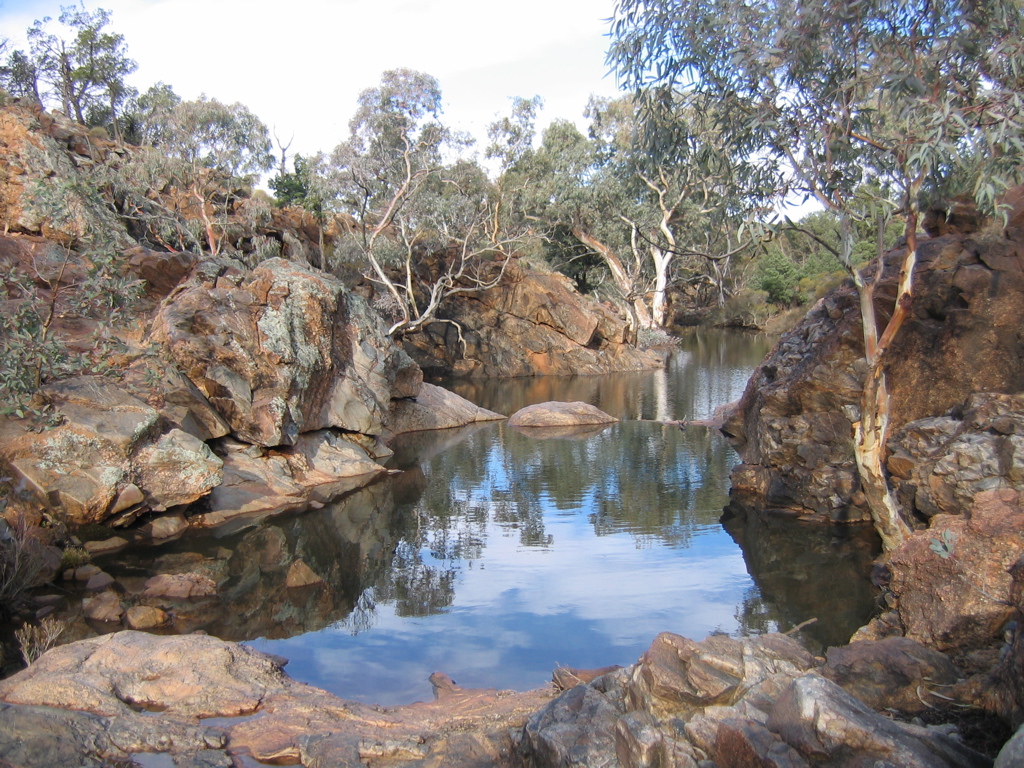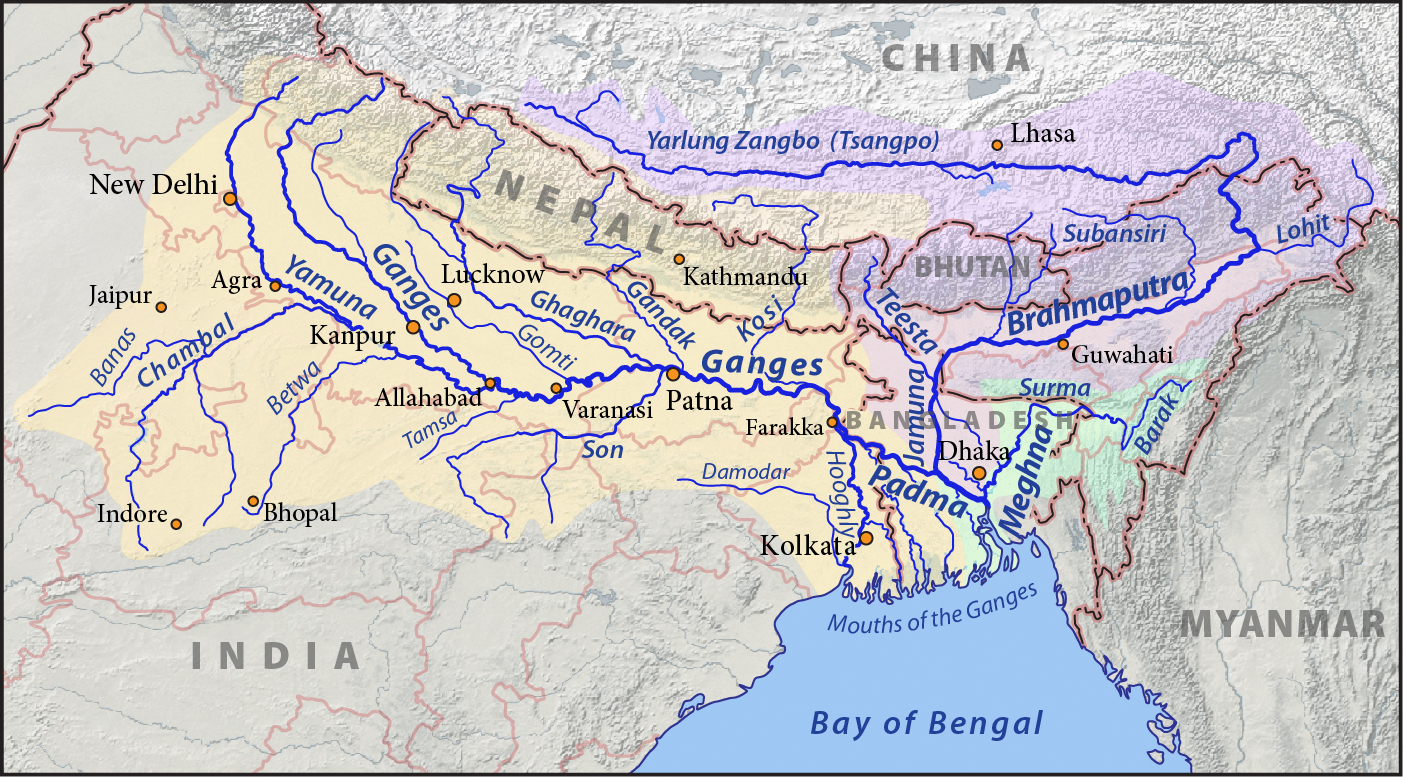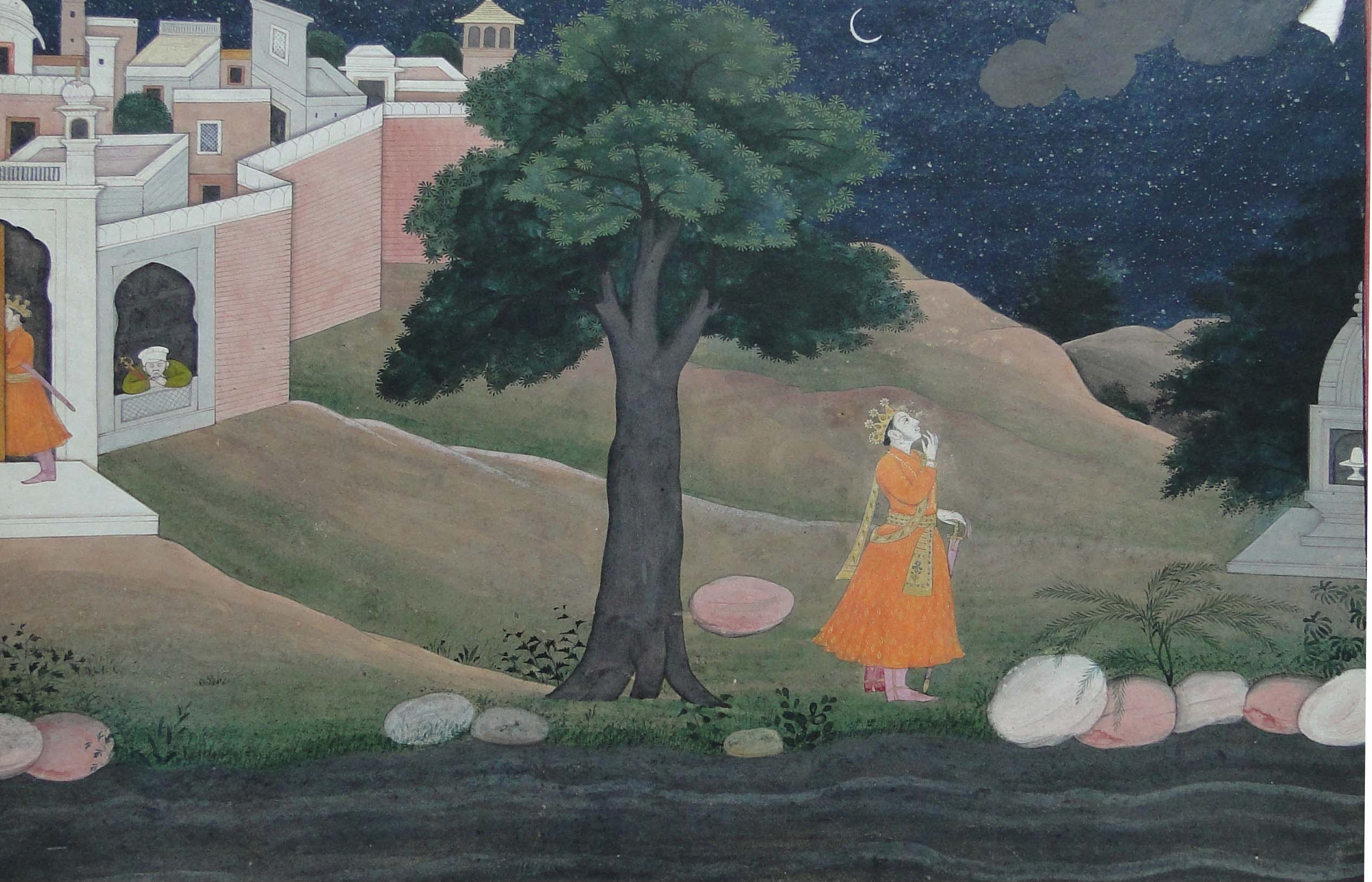|
Gambhir River, Rajasthan
The Gambhir River, which is also known as the Utangan River, is an ephemeral (seasonal) river in India which originates in Rajasthan state and confluences with Yamuna in Uttar Pradesh state. Important tributaries of the Gambhir are Banganga, Sesa, Kher and Parbati. It originates near Karoli in Rajasthan and flows around Hindaun City, then through Bharatpur district, and through Dholpur district where it forms the boundary between Uttar Pradesh and Rajasthan states. It then enters Mainpuri district of Uttar Pradesh to finally confluence with Yamuna. It supplies water to the Keoladeo National Park near Bharatpur in Rajasthan. Basin Origin It originates from Karauli in Rajasthan and flows around Hindaun City. It flows from south to north up to Kanjoli-Katara Aziz village (Toda Bhim), then towards northeast up to village Mertha of Roopbas Block, before entering Uttar Pradesh. The river again enters Rajasthan near Catchapaura village in Dholpur District and forms the bou ... [...More Info...] [...Related Items...] OR: [Wikipedia] [Google] [Baidu] |
Ephemerality
Ephemerality (from the Greek word , meaning 'lasting only one day') is the concept of things being transitory, existing only briefly. Academically, the term ephemeral constitutionally describes a diverse assortment of things and experiences, from digital media to types of streams. "There is no single definition of ephemerality". With respect to unique performances, for example, it has been noted that " hemerality is a quality caused by the ebb and flow of the crowd's concentration on the performance and a reflection of the nostalgic character of specific performances". Because different people may value the passage of time differently, ephemerality may be a relative, perceptual concept: "In brief, what is short-lived may not be the object itself, but the attention we afford it".Ronald Beiner, ''Political Philosophy: What It Is and Why It Matters'' (2014), p. 10. Ephemerality and nature Geographical features An ephemeral stream is that which only exists following precipitation ... [...More Info...] [...Related Items...] OR: [Wikipedia] [Google] [Baidu] |
Arvari River
The Arvari River, which originates in Aravalli range, is a small river flowing through the Alwar District of Rajasthan, India. It has a total length of 45 km (28 mi) and a total basin area of 492 squared kilometers. Downstream of the Sainthal Sagar dam on Arvari, the Arvari river meets Sarsa River to become the Sanwan River. The Sanwan meets the Tildah and Banganga rivers to converge with the Gambhir (also known as the Utang river). Gambhir then converges with the Yamuna in Mainpuri district of Uttar Pradesh, Yamuna converges with Ganges at Triveni Sangam in Prayagraj. It is notable for having its flow restored after being dry for 60 years. This process began in 1986, and required the efforts of the people of the Bhanota-Kolyala village, with the help of Dr. Rajendra Singh. The villages that lay in the river's catchment area built earthen dams, with largest being a 244 m long and 7 m wide. Following the construction of 375 dams, the river started to flow again, becomin ... [...More Info...] [...Related Items...] OR: [Wikipedia] [Google] [Baidu] |
Geography Of Ujjain
Geography (from Greek: , ''geographia''. Combination of Greek words ‘Geo’ (The Earth) and ‘Graphien’ (to describe), literally "earth description") is a field of science devoted to the study of the lands, features, inhabitants, and phenomena of Earth. The first recorded use of the word γεωγραφία was as a title of a book by Greek scholar Eratosthenes (276–194 BC). Geography is an all-encompassing discipline that seeks an understanding of Earth and its human and natural complexities—not merely where objects are, but also how they have changed and come to be. While geography is specific to Earth, many concepts can be applied more broadly to other celestial bodies in the field of planetary science. One such concept, the first law of geography, proposed by Waldo Tobler, is "everything is related to everything else, but near things are more related than distant things." Geography has been called "the world discipline" and "the bridge between the human and th ... [...More Info...] [...Related Items...] OR: [Wikipedia] [Google] [Baidu] |
Rivers Of Rajasthan
A river is a natural flowing watercourse, usually freshwater, flowing towards an ocean, sea, lake or another river. In some cases, a river flows into the ground and becomes dry at the end of its course without reaching another body of water. Small rivers can be referred to using names such as creek, brook, rivulet, and rill. There are no official definitions for the generic term river as applied to geographic features, although in some countries or communities a stream is defined by its size. Many names for small rivers are specific to geographic location; examples are "run" in some parts of the United States, "burn" in Scotland and northeast England, and "beck" in northern England. Sometimes a river is defined as being larger than a creek, but not always: the language is vague. Rivers are part of the water cycle. Water generally collects in a river from precipitation through a drainage basin from surface runoff and other sources such as groundwater recharge, springs, a ... [...More Info...] [...Related Items...] OR: [Wikipedia] [Google] [Baidu] |
Geography Of Malwa
Geography (from Greek: , ''geographia''. Combination of Greek words ‘Geo’ (The Earth) and ‘Graphien’ (to describe), literally "earth description") is a field of science devoted to the study of the lands, features, inhabitants, and phenomena of Earth. The first recorded use of the word γεωγραφία was as a title of a book by Greek scholar Eratosthenes (276–194 BC). Geography is an all-encompassing discipline that seeks an understanding of Earth and its human and natural complexities—not merely where objects are, but also how they have changed and come to be. While geography is specific to Earth, many concepts can be applied more broadly to other celestial bodies in the field of planetary science. One such concept, the first law of geography, proposed by Waldo Tobler, is "everything is related to everything else, but near things are more related than distant things." Geography has been called "the world discipline" and "the bridge between the human and t ... [...More Info...] [...Related Items...] OR: [Wikipedia] [Google] [Baidu] |
List Of Rivers Of India
This is a list of rivers of India, starting in the west and moving along the Indian coast southward, then northward. Tributary rivers are listed hierarchically in upstream order: the lower in the list, the more upstream. The overall discharge of rivers in India or passing/originating in India : List of rivers of India by discharge The major rivers of India are: * Flowing into the Arabian Sea: Narmada, Tapi, Sindhu, Sabarmati, Mahi, Purna * Flowing into the Bay of Bengal: Brahmaputra, Yamuna, Ganga, Meghna, Mahanadi, Godavari, Krishna, Kaveri, Penna River Mizoram and Bangladesh. Meghna River Basin The Meghna-Surma-Barak River System is located in India and Bangladesh. * Meghna River (in the Bangladesh) ** ** Dhaleshwari River ** Dakatia River ** Gumti River ** Feni River ** Tista River, also called the Haora River ** Surma River *** Kangsha River **** Someshwari River ** Kushiyara River *** Manu River ** Barak River *** Tuivai River *** Irang River Ganges River Ba ... [...More Info...] [...Related Items...] OR: [Wikipedia] [Google] [Baidu] |
List Of Rivers Of Rajasthan
The list of rivers of Rajasthan in India. A * Arvari River, Alwar * Magan River B * Banas River * Berach River * Bandi River * Banganga River (Rajasthan) * Bhagani River Alwar C * Chambal River D * Dohan river, tributary of Sahibi River, originates near Neem Ka Thana in Alwar district G * Gambhir River * Ghaggar-Hakra River with numerous Sarasvati-Indus Civilization sites such as Sothi, Banawali, Lohari Ragho, Rakhigarhi, Kunal, etc ** Paleo rivers *** Sarasvati River, paleo name of Ghaggar-Hakra River *** Drishadvati river, paleo tributary of Ghaggar River ** Present day tributary **** Chautang, present day remnant of the paleo Drishadvati river * Gomati River (Rajasthan) * Garri River J * Jawai River * Jahajwali River K * Kali Sindh River * Krishnavati river, tributary of Sahibi River L * Luni River R * Ruparel River Alwar * Rupangarh River Kucheel S * Sarasvati River, paleo river * Sabarmati River * Sahibi River * Sarsa River, flows through ... [...More Info...] [...Related Items...] OR: [Wikipedia] [Google] [Baidu] |
Sahibi River
The Sahibi river, also called the Sabi River, is an ephemeral, rain-fed river flowing through Rajasthan, Haryana (where its canalised portion is called the "Outfall Drain No 8") and Delhi states in India. It drains into Yamuna in Delhi, where its channeled course is also called the Najafgarh drain, which also serves as Najafgarh drain bird sanctuary. Sahibi is a seasonal river which is 300 km long and flows from Aravalli hills in Rajasthan to Haryana,Ropeway for tourist pull at barrage site , 17 Mar 2017. of which 100 km is in Haryana. The current and |
Meghadūta
} ''Meghadūta'' ( sa, मेघदूत literally ''Cloud Messenger'') is a lyric poem written by Kālidāsa (c. 4th–5th century CE), considered to be one of the greatest Sanskrit poets. It describes how a ''yakṣa'' (or nature spirit), who had been banished by his master to a remote region for a year, asked a cloud to take a message of love to his wife. The poem become well-known in Sanskrit literature and inspired other poets to write similar poems (known as "messenger-poems", or Sandesha Kavya) on similar themes. Korada Ramachandra Sastri wrote ''Ghanavrttam,'' a sequel to ''Meghduta.'' About the poem A poem of 120 stanzas, it is one of Kālidāsa's most famous works. The work is divided into two parts, Purva-megha and Uttara-megha. It recounts how a yakṣa, a subject of King Kubera (the god of wealth), after being exiled for a year to Central India for neglecting his duties, convinces a passing cloud to take a message to his wife at Alaka on Mount Kailāsa in the Himā ... [...More Info...] [...Related Items...] OR: [Wikipedia] [Google] [Baidu] |
Kalidasa
Kālidāsa (''fl.'' 4th–5th century CE) was a Classical Sanskrit author who is often considered ancient India's greatest poet and playwright. His plays and poetry are primarily based on the Vedas, the Rāmāyaṇa, the Mahābhārata and the Purāṇas. His surviving works consist of three plays, two epic poems and two shorter poems. Much about his life is unknown except what can be inferred from his poetry and plays. His works cannot be dated with precision, but they were most likely authored before the 5th century CE. Early life Scholars have speculated that Kālidāsa may have lived near the Himalayas, in the vicinity of Ujjain, and in Kalinga. This hypothesis is based on Kālidāsa's detailed description of the Himalayas in his ''Kumārasambhava'', the display of his love for Ujjain in ''Meghadūta'', and his highly eulogistic descriptions of Kalingan emperor Hemāngada in '' Raghuvaṃśa'' (sixth ''sarga''). Lakshmi Dhar Kalla (1891–1953), a Sanskrit scholar a ... [...More Info...] [...Related Items...] OR: [Wikipedia] [Google] [Baidu] |
Climate Change
In common usage, climate change describes global warming—the ongoing increase in global average temperature—and its effects on Earth's climate system. Climate change in a broader sense also includes previous long-term changes to Earth's climate. The current rise in global average temperature is more rapid than previous changes, and is primarily caused by humans burning fossil fuels. Fossil fuel use, deforestation, and some agricultural and industrial practices increase greenhouse gases, notably carbon dioxide and methane. Greenhouse gases absorb some of the heat that the Earth radiates after it warms from sunlight. Larger amounts of these gases trap more heat in Earth's lower atmosphere, causing global warming. Due to climate change, deserts are expanding, while heat waves and wildfires are becoming more common. Increased warming in the Arctic has contributed to melting permafrost, glacial retreat and sea ice loss. Higher temperatures are also causing m ... [...More Info...] [...Related Items...] OR: [Wikipedia] [Google] [Baidu] |
Perennial Stream
A perennial stream is a stream that has continuous flow of surface water throughout the year in at least parts of its catchment during seasons of normal rainfall, Water Supply Paper 494. as opposed to intermittent river, one whose flow is intermittent. In the absence of irregular, prolonged or extreme drought, a perennial stream is a watercourse, or segment, element or emerging body of water which continually delivers groundwater. For example, an damming, artificial disruption of stream, variability in flow or stream selection associated with the activity in hydropower installations, do not affect this status. Perennial streams do not include stagnant water (stream pool, pools and puddle, waterholes), reservoirs, oxbow lake, cutoff lakes and ponds that persist throughout the year. All other streams, or parts of them, should be considered seasonal rivers or lakes. The stream can cycle from intermittent to perpetual through multiple iterations. Stream Definition The basic conc ... [...More Info...] [...Related Items...] OR: [Wikipedia] [Google] [Baidu] |





